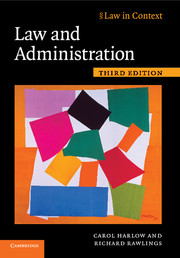Book contents
- Frontmatter
- Contents
- Preface
- Table of Cases
- Table of Statutes
- 1 Red and green light theories
- 2 The changing state
- 3 Transforming judicial review
- 4 Making the law
- 5 Rules and discretion
- 6 Regulation and governance
- 7 Regulatory design and accountability
- 8 Contractual revolution
- 9 Contract, contract, contract
- 10 Into the jungle: Complaints, grievances and disputes
- 11 Tribunals in transition
- 12 The Parliamentary Ombudsman: Firefighter or fire-watcher?
- 13 Inquiries: A costly placebo?
- 14 Continuity and change: Procedural review
- 15 Elite dimension: Court structures and process
- 16 Judicial review and administration: A tangled web
- 17 ‘Golden handshakes’: Liability and compensation
- Index
11 - Tribunals in transition
Published online by Cambridge University Press: 05 June 2012
- Frontmatter
- Contents
- Preface
- Table of Cases
- Table of Statutes
- 1 Red and green light theories
- 2 The changing state
- 3 Transforming judicial review
- 4 Making the law
- 5 Rules and discretion
- 6 Regulation and governance
- 7 Regulatory design and accountability
- 8 Contractual revolution
- 9 Contract, contract, contract
- 10 Into the jungle: Complaints, grievances and disputes
- 11 Tribunals in transition
- 12 The Parliamentary Ombudsman: Firefighter or fire-watcher?
- 13 Inquiries: A costly placebo?
- 14 Continuity and change: Procedural review
- 15 Elite dimension: Court structures and process
- 16 Judicial review and administration: A tangled web
- 17 ‘Golden handshakes’: Liability and compensation
- Index
Summary
In Chapter 10, we introduced the topic of administrative justice, adopting a bottom-up approach. We considered ways of resolving disputes without resort to the formal machinery of tribunals and courts. The commonly held view of tribunals as court substitutes was recorded but never unpacked. It is now time to consider this view more carefully and look more closely at the evolution of tribunals. They have moved a long way from humble beginnings to the place they occupy today as the standard machinery for alternative dispute resolution in administrative law. Situated near the top of the pyramid, they now possess their own integrated tribunals service and, at appellate level, stand in near proximity to the courts. We shall see that procedures have also converged, with courts becoming more flexible after Lord Woolf's review of civil procedure and tribunals becoming more formal. The Tribunals, Courts and Enforcement Act 2007 (TCEA) sees a partial assimilation of the two adjudicative systems, representing, we shall argue, a final acknowledgment of the position of tribunals as court substitutes.
Without tribunals, the court system would quite simply break down and machinery for alternative dispute resolution would need to be heavily augmented. As Table 11.1 shows, some tribunals handle very large case loads. The combined total of enquiries addressed to the Parliamentary Commissioner for Administration (PCA) and Health Services Commissioner (see Chapter 12) averages 12,000 annually, of which around 1,000 are accepted for investigation. The load of the Commission for Local Administration is larger, averaging 18,000 complaints annually, of which in the region of 90 per cent are determined.
- Type
- Chapter
- Information
- Law and Administration , pp. 486 - 527Publisher: Cambridge University PressPrint publication year: 2009



